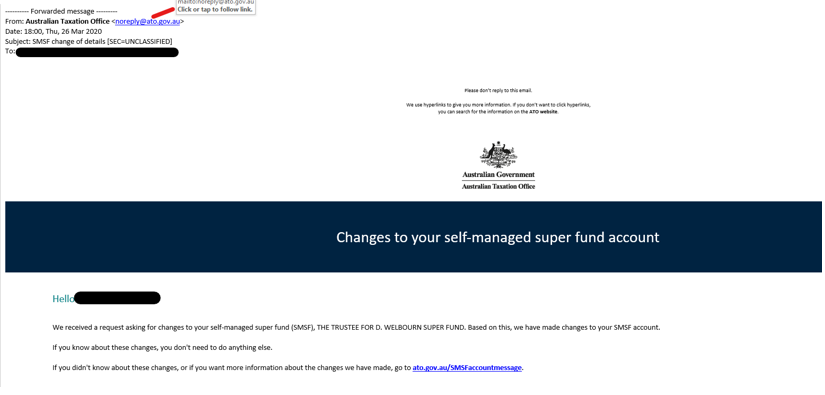
By Anthony Cullen
ATO correspondence that isn't spam
Have you recently received a suspicious looking email or text message, purportedly from the ATO? Turns out, it may actually be legitimate. That’s not to say you shouldn’t still approach it with caution, but it may pay to take note of what it is saying.
In early February 2020, the ATO rolled out a messaging service for trustees of SMSFs to alert them to certain changes that had been reported to them. The purpose of the initiative is to reduce the risk of fraud and misconduct. If any of the following information is updated with the ATO, they will reach out directly to the trustees in a bid to confirm the authenticity of the changes;
Some of this information is updated when your SMSFs Annual Return (tax return) is lodged and this may be the trigger for you receiving an email or text. We have noticed that a change to the ESA is frequently the reason for the correspondence from the ATO.
The purpose of an ESA is to allow for data relating to rollovers and contributions to be transferred electronically between different super funds and employers. Even though you may not need an ESA, all reputable, dedicated superannuation accounting software programs will have an ESA assigned to each fund. The two common changes we are seeing relating to the ESA have been;
Below is an example of the type of email you may receive:

Admittedly it does look suspicious and the type of email the ATO would warn you about. If you ever have concerns about the origins of any email, one thing you can do is use your mouse to hover over the email address the message has come from. In the above, you can see when I did this, the pop-up window details are identical to the address the email is purported to have come from (as you would expect). Most scam emails will have a different address in the pop-up to the one you are seeing as the ‘from’ address and is a good indication of a potential troublesome email.
In a similar fashion, you can also hover your mouse over any links/URLs within the email body to check the link is as expected, i.e. the ATO (as per the below).

If you are still wary of following any links, one option is to search for details directly via your internet browser. A quick search for ato.gov.au/SMSFaccountmessage (as appears in the above email) revealed the ATO’s website and further information in relation to this matter. You can find the ATO’s page on these alerts here.
If you have received an email and you do have concerns about it, please feel free to contact us to discuss further. Vigilance is the key and there may be a plausible explanation for you receiving the email.